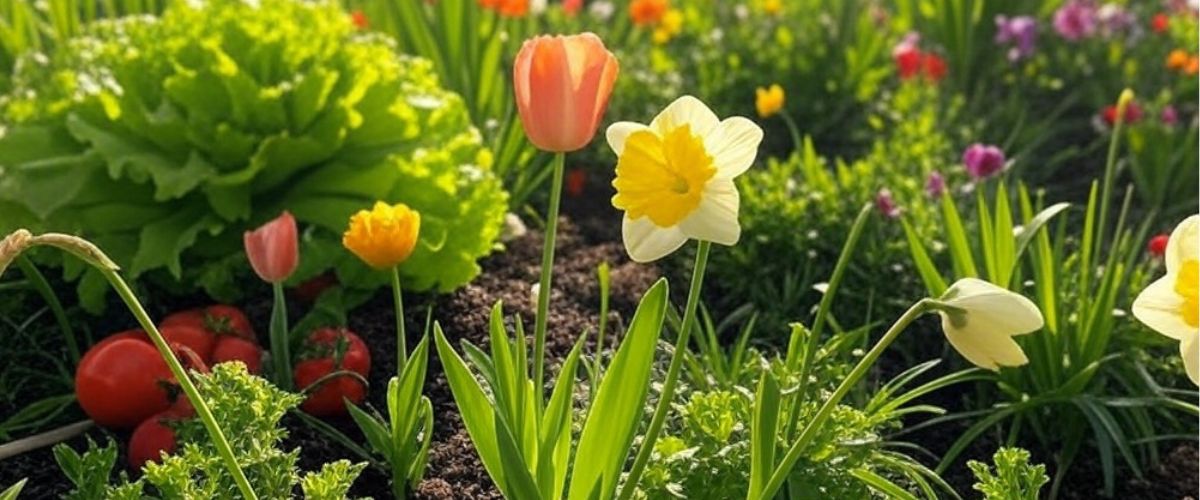Exclusive Q&A: Growing Success with David Fryer, Head of Technical at Mr Fothergill’s Seeds
From common gardening pitfalls to this year’s must-grow veggies, expert David Fryer shares his top tips for transitioning from winter to a thriving spring garden.

Spring is here, March has arrived, and Christmas feels like a distant memory—though before we know it, it’ll be back! But right now, it’s time to get outside and start planting.
The days are getting longer, the soil is waking up, and there’s so much to grow! But what’s in for this season? And what mistakes should we avoid?

We spoke to expert David Fryer, Head of Technical at Mr Fothergill’s Seeds Ltd, whose passion for horticulture has shaped his entire career. With a BSc (Hons) in Horticulture from Reading University, David got his start picking tomatoes and cucumbers in the Lee Valley before advising growers on pest prevention and irrigation for the Ministry of Agriculture.
He then took his expertise to Tesco, ensuring top-quality plants for customers worldwide. Now, at Fothergill’s, he oversees seed sourcing, germination testing, and growing trials—helping gardeners get the best results, season after season!
What’s the biggest mistake big retailers make when buying seeds and plants for spring?
Big retailers don’t always capture the full sales potential of their seed and plant ranges. This is a missed opportunity, as many gardening enthusiasts wish to start planning for the year ahead.
Early-sow varieties like tomatoes and peppers should ideally hit the shelves in January or February, allowing gardeners a head start. Yet, many retailers delay stock placement until peak sowing season, missing valuable early-season sales. Introducing key varieties earlier—even in a limited range—could help meet demand.
Weather plays a crucial role in driving sales, with even short bursts of sunshine leading to an immediate uplift in sales. Retailers closely monitoring weather forecasts and adjusting inventory accordingly will be better positioned to maximize sales.
Bank holidays, including Easter and Mother’s Day, present another untapped opportunity. While retailers focus heavily on gifting products, seasonal garden seeds and plants could see significant sales boosts if stocked in sufficient quantities. Too often, displays are left empty after these key trading periods—suggesting that demand exceeds supply while gifting items are marked down to clear.
For retailers looking to optimize garden sales, stocking early, responding to weather trends, and capitalizing on seasonal events are simple yet effective strategies to drive growth. With a little foresight, they can ensure their shelves are full when customers are most eager to buy—rather than missing out on valuable sales.
If Tesco (or any other major supermarket) asked for a “trendy” vegetable to push this spring, what would you recommend and why?
Some exciting vegetable trends are emerging, and picking the right one could make all the difference in engaging customers.
Firstly, I’d suggest fun, family-friendly vegetables, like Sweet Corn varieties explicitly grown for Popcorn. It’s a fantastic way to get the whole family involved in gardening—from planting and growing to harvesting and, of course, popping! It’s an interactive, rewarding experience that brings a bit of fun to homegrown food.
Another big trend is the growing interest in heritage and heirloom vegetables with exceptional flavour. Varieties like Cream Sausage, Pink Brandywine, and Bloody Butcher tomatoes have fantastic names and come in a stunning array of colours, shapes, and tastes you just won’t find in your average tomato selection. These varieties offer something unique for food lovers who are experimenting with vibrant, delicious, homegrown produce.
And, of course, superfoods are still very much in demand. Broccoli, for example, remains a solid favourite—it’s nutrient-packed, well-known for its health benefits, and fits perfectly into the wider trend of wellness and mindful eating.
By tapping into these trends—fun gardening experiences, bold and exciting flavours, or nutrient-dense superfoods—retailers can offer something fresh and inspiring to customers this spring.
What’s one piece of old-school gardening advice that you think needs to be retired?
Double-digging has been a long-standing garden technique, but honestly, it’s not as essential as many people think—and in some cases, it can do more harm than good!
Double digging aims to aerate the soil and improve drainage by digging to twice the spade’s depth. While that might sound beneficial, it can disrupt your soil’s natural structure and disturb its helpful life—such as earthworms, fungi, and insects that help maintain a healthy ecosystem underground.
A much better approach is to embrace minimal or even no-dig gardening. Adding organic matter to the surface instead of turning the soil encourages natural soil processes, improves its health, and reduces weeds—all without heavy labour. Plus, by skipping the digging, you can focus your time and energy on more productive and enjoyable tasks in the garden.
I would advise working with nature, not against it—your soil, plants, and back will thank you.
How do supermarket retailers tailor seed and plant procurement to supermarket retailers during the winter-to-spring transition?
Supermarkets often focus entirely on Christmas during the winter months, meaning seeds and plants take a back seat. However, breaking that year-round availability—especially for seeds—can harm sales.
Gardeners love to plan, and autumn is the perfect time to stock spring-sowing seed varieties. Even outside the traditional sowing window, many shoppers buy seeds early to ensure their favourites are ready for the new season. After all, what worked well in their garden over the summer is still fresh in their minds, making autumn the ideal time to tempt them with trusted varieties for the year ahead. Gardens may have also inspired shoppers they’ve visited and will be keen to pick up varieties they’ve seen before the memory fades.
Beyond seeds, garden centres and supermarket plant sections can brighten the colder months with colourful autumn/winter plants. Many gardens start to look tired as the season changes, but plenty of fantastic plant options thrive in the colder months. Pansies, primulas, winter heathers, Christmas roses, camellias, dogwoods, mahonias, photinias, ornamental grasses, and bulbs bring vibrant colour, texture, and life when gardens need them most.
By keeping seeds and seasonal plants available throughout the winter, retailers can tap into customers’ enthusiasm for gardening all year round, ensuring they don’t miss out on early sales opportunities while helping shoppers keep their gardens looking their best.
What are the best ‘plant-and-forget’ seeds for first-time gardeners transitioning from winter to spring—no pruning, no fuss?
You’d be surprised how many seeds you can sow during winter and early spring with minimal effort! Whether you have a windowsill, a greenhouse, or a tiny garden space, plenty of low-maintenance options require little attention but deliver outstanding results.
For outdoor sowing, broad beans (Aguadulce) and peas (Meteor) are fantastic winter-hardy choices—you can plant them in autumn, and they’ll start growing as soon as conditions improve in early spring. If you’re looking for easy flowers, marigolds, poppies, and wildflower mixes are great options. These will start growing once the weather warms up, adding colour and attracting pollinators without any extra effort.
If you have a cold frame or tunnel, you can try kale and winter lettuces, as long as they’re kept frost-free. Sweet peas are another excellent choice—they’ll establish early and reward you with stunning blooms by late spring.
For those with a greenhouse or a bright windowsill, winter is the perfect time to get a head start on spring sowing. Tomatoes and peppers benefit from an early start indoors, helping to extend your cropping season for a more prolonged, more productive harvest.
And, if you want something straightforward, you can sow herbs like basil, coriander, and parsley indoors all winter long. Microgreens like rocket, cress, and pea shoots are also fantastic—they grow fast, require little space, and add fresh flavour and nutrition to your meals.
No matter your gardening experience, there are so many easy, no-fuss seeds to grow from winter into spring—it’s just about choosing the right ones for your space and enjoying the rewards!
A huge thank-you to David for sharing all of this amazing information. We’re off to get the gardening gloves on and start planting!
Fancy growing your Christmas Day dinner vegetables? Then these tips are exactly what you’ll need.






